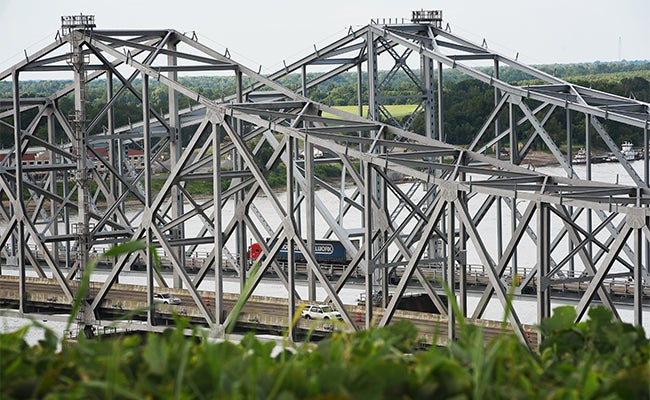Bridge expert: ’We are as safe as possible’ in Miss Lou
Published 4:12 pm Tuesday, March 26, 2024

- Trucks and cars travel across the Mississippi River bridges that connect Natchez and Vidalia. (Democrat file photo)
|
Getting your Trinity Audio player ready...
|
NATCHEZ — The tragic collapse of a Baltimore, Maryland, bridge struck by a cargo ship early Tuesday may raise concerns about the twin bridges spanning the Mississippi River here, but two experts are quick to point out the differences.
“Can a boat hit our bridges and knock them down? Yes. It’s very unlikely, but the answer is yes,”said Herman Smith, superintendent of the Vicksburg Bridge Commission.
Anthony Hauer, director of the Port of Natchez and Adams County, agrees with Smith.
“One thing is for sure. The bridge in Baltimore was hit by a ship. We don’t have those in Natchez,” Hauer said.
Also, Hauer said the upper portions of the ship struck the bridge in Baltimore, contributing to its collapse.
“We believe most of the impacts to our bridges in the past have been only glancing blows. And we have been hit by the lower portions of the boats or barges,” he said.
When he learned of the tragic collapse of the Francis Scott Key Bridge in Baltimore, Maryland, Smith began to research the bridge and how it was engineered and built. The commission he oversees governs the old Highway 80 railroad bridge in Warren County.
That bridge, constructed in 1930, is a private enterprise. While Warren County owns the bridge, the bridge commission is appointed to run and maintain it as an entity separate from the county.
At approximately 1:27 a.m. EDT, a ship, known as Dali, Smith said, struck the bridge, leading to its collapse.
“The Francis Scott Key Bridge was not designed to be hit from the side, and that’s what happened,” Smith said. “They have a lot of granite and rock in that area and the piers of that bridge were placed on top of granite and rock. That bridge was designed for traffic to go across it and for ships to go under it.”
In contrast, bridges like those in Vicksburg and ours in Natchez are designed knowing they are likely to be hit by barges and similar heavy vessels from all angles, he said.
The ship that struck the Baltimore bridge from the side weighed in the neighborhood of 95,000 tons, Smith said.
“They will make a determination later on about what happened to cause this bridge to collapse, but the fact is, that ship hit that pier sideways. It’s not designed to withstand that. That’s why it tumbled,” he said. “Our piers are made out of concrete and they are designed to hold the bridge up. They were designed knowing that barges and boats are going to strike those piers. They were designed with that kind of impact in mind.
The piers holding up the Interstate 20 bridges in Vicksburg, the U.S. 84-90 bridges at Natchez and the old Highway 80 railroad bridge in Vicksburg have at least 15 feet thick concrete on the face of them. Smith said the U.S. Coast Guard started keeping records of bridge strikes in the 1970s and the railroad bridge has been hit more than 300 times since that time, and obviously, many more times than that since it was constructed.
“That’s why we can take a hit and the piers still stay up. Now, it shakes the bridge and will knock a little concrete off of it, but it is so solid and its foundation is so stable,” he said.
While the ship that hit the bridge in Baltimore weighed 95,000 tons and carried more than 2,200 gallons of fuel, a “triple screw” towboat — one with three engines and three propellers, among the largest traveling the Mississippi — weighs about 919 tons. A barge filled with grain or coal weighs about 1,500 tons.
“One of the things everybody has to understand is that all bridges up and down the Mississippi River are inspected every year. And these bridge engineers know what they are looking for,” Smith said. “We are as safe as possible when we cross those bridges.”





